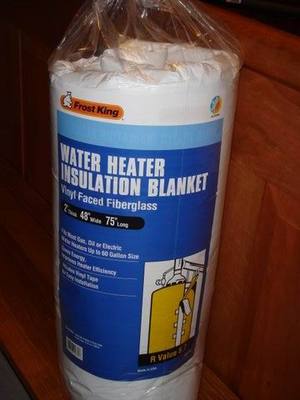As gas and energy prices soar, more and more people are paying attention to energy conservation in the home. This summer has heralded a huge boom in replacement windows, insulated shades, and energy efficient appliances in my northern New England neighborhood. Insulation, both in your home and around your hot water heater, is one of the easiest and most cost-effective way to decrease energy consumption in the home. According to the Alliance to Save Energy (www.ase.org), about 15 percent of an average home energy bill goes to heating water. The US Department of Energy (www.eere.energy.gov) indicates that a well insulated hot water storage tank can significantly reduce water heating expenses by cutting back on “standby” heat loss (heat from hot water dissipating into the surrounding room) by twenty-five to forty-five percent. If you’re not sure whether or not your water heater would benefit from insulation, just touch it. If the tank feels warm, it needs additional insulation. Fortunately, insulating a home hot water heater is a snap, and even the greenest of do-it-yourselfers will be able to complete the task in under an hour, and for less than fifty bucks.
Materials needed:
– Water heater blanket or cover
– Pipe insulation (optional)
– Rigid insulation for electric water heaters (optional)
Before you head to the hardware store, get some rough measurements of your water heater. Most of these come in standard sizes, and the blankets themselves have some room for adjustment, but things will be easier if you buy the right blanket for your heater. Purchase a blanket with the highest R-value that you can afford. The higher the R-rating on the blanket, the more effective your insulation will be. Once you’ve got a blanket, you’re ready to go.
Follow the directions that came with your insulating blanket to place it around the water heater. If there are no instructions, it’s usually pretty self explanatory. Clean the outside of your water tank with a damp sponge, and allow it to dry before proceeding. Shake out the blanket, open the slit, and slide it down over the tank, taking care to align the openings for input and outflow pipes, as well as emergency overflow valves properly. If you’re insulating an electric tank, that’s all there is to it, pull the blanket snugly around the water heater, overlapping the edges if possible, and seal well with tape. If you’re insulating a gas heater, read your instructions carefully – gas heaters need to be vented in order to provide enough oxygen for the pilot light and burners to function. Many blankets come with cutting templates already printed on the blanket. Cut these out with scissors or a razor knife, and proceed as you would with the electric heater.
That’s all there is to it for basic insulation. If you want to make your insulation as effective as possible, there are a few more steps you can take. One such option is to insulate the hot water outlet pipes on the tank. These pipes are almost always copper, and conduct heat very well into the surrounding air. Foam sleeve-type insulation is inexpensive and easy to work with. Simply pull it open, slide it over the pipes, and tape it closed. The pipe closest to the water heater itself it the most important. Another great option for electric tanks is to insulate the tops and bottoms of the tank. To do this, you’ll need to move the tank itself, so this job is best done when replacing or servicing the unit. Simply cut rigid insulation to size and place the water heater on top. Easy peasy! Note that this can only be done safely with electric water heaters. Gas heaters are a little bit fussy.
There! Insulating a hot water heater is a cheap, quick, and easy project for homeowners that pays off quickly in energy savings. Homeowners know that this combination is rare, so it’s also a no-brainer. Get to it.




